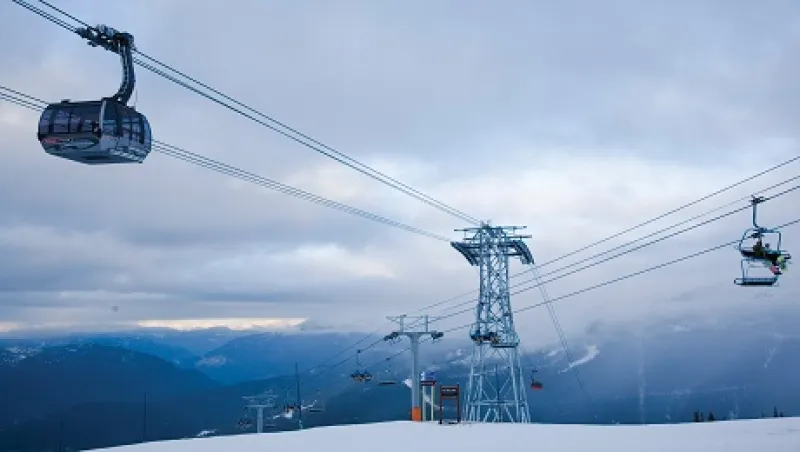I don’t run, I don’t lift weights, and I don’t frequent a gym. I admire those who do, but that’s not for me. In the summer I ride a bicycle to work; in the winter my kids and I ski.
Alpine skiing is probably the laziest winter sport ever invented — gravity takes you down, the lift takes you back up. (Okay, some may argue that bobsledding is the laziest winter sport; after all, you don't even have to stand.) The skiing experience has improved dramatically over the past few decades. Shorter, parabolic-shaped skis have made the sport much easier and thus accessible to a much larger demographic, including couch potatoes like me. High-speed lifts are two and a half times faster than the old fixed-grip lifts, giving skiers more time on the slopes.
These improvements have made ski resorts more popular. Ski venue visits grew about 2 percent a year over the past decade. I live in Denver and frequent local mountains, so I looked at Vail Resorts as an investment. The only publicly traded ski resort in the U.S., Vail is an extremely well managed and unique asset, but it always looks expensive and lacks free cash flows.
I recently stumbled on another, no-less-intriguing ski resort: Whistler Blackcomb in British Columbia. The owner connected two mountains (predictably named Whistler and Blackcomb) 90 minutes from Vancouver to create the largest ski resort in North America. If the name sounds familiar, it is: Whistler Blackcomb hosted the alpine events for the 2010 Winter Olympics.
The Olympics had a profound impact on the resort. The Canadian government spent half a billion dollars on improving Highway 99 from Vancouver to Whistler Blackcomb, and this has increased visits by locals by 300,000 a year. The Olympics also increased awareness and cemented the reputation of Whistler Blackcomb’s brand. Last, having the winter games at the resort increased lodging capacity.
Unlike Vail Resorts, Whistler Blackcomb is not a real estate development company, nor does it own hotels. It has an asset-light model that produces much higher free cash flows than Vail. Half of its revenue comes from selling tickets, and the rest is from ski rentals, ski schools and restaurants. It leases the mountains from British Columbia and pays the province a small royalty on ticket sales. Hotel occupancy is now just 62 percent during peak season. That could change. The fact that Whistler Blackcomb doesn’t own hotels creates an interesting dynamic: Hotels have a considerable incentive to promote its resorts. I'd argue that a 38 percent vacancy rate creates an enormous incentive.
Whistler Blackcomb’s mountains attract two types of visitor: locals — those who travel less than 250 miles — and destination visitors, who travel from further points in Canada, the U.S., Europe and other regions. The number of annual destination visits dropped by 200,000 over the past five years as a result of the weak global economy, decline in the euro and strength of the Canadian dollar.
For ski resorts, destination visitors are the gravy train. They spend about 30 percent more per visit than locals do, on ski rentals, ski lessons and restaurant meals (locals often pack their lunch). They also pay a much higher price per lift ticket per day than locals. If Whistler Blackcomb can regain the destination visitors it lost, its free cash flow should grow by 20 to 30 percent.
A good ski resort is a scarce asset. Though skiing is a discretionary activity, ski resorts have had significant pricing power. They have raised prices about 3 percent a year forever. Whistler Blackcomb serves an upscale demographic that has been conditioned to expect higher ticket prices.
Until recently, Whistler Blackcomb was owned by resort operator Intrawest. But Intrawest got overleveraged and was forced to do an IPO of Whistler Blackcomb in November 2010. As a result of the IPO, all assets had to be revalued, and depreciation and amortization are far in excess of capital expenditures. Thus earnings meaningfully understate Whistler Blackcomb’s true moneymaking power. If valued on earnings, it trades at a very unexciting price-earnings ratio of 30; however, if valued on free cash flow, it trades at a multiple of 10.
The biggest risk facing Whistler Blackcomb is the Canadian economy — specifically, the Canadian housing bubble. The Canadians looked at the U.S. housing bubble, liked it and made it their own. The bursting of the bubble would decrease visits by locals and drive down the Canadian dollar, reducing earnings and dividends in U.S. dollars. But there would be a silver lining: A weaker Canadian dollar would make Whistler Blackcomb more affordable and bring back destination visitors.
In a recent column I mentioned the importance of dividends. Well, Whistler Blackcomb is a perfect high-quality, high-dividend-yielding stock. In fact, I look at it as the equivalent of an inflation-protected, undervalued bond yielding 7.4 percent, with optionality for growth when the global economy improves.
Vitaliy Katsenelson (vk@imausa.com) is CIO at Investment Management Associates in Denver and author of The Little Book of Sideways Markets.






